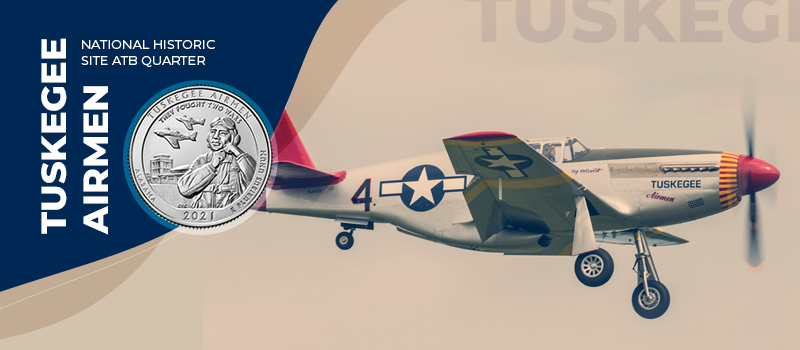Tuskegee Airmen National Historic Site ATB quarter

During their more than four centuries worth of struggle against racial discrimination and segregation, African Americans did not lose their will to better their lives. In the Second World War, the exclusive 99th squadron of African-American pilots, called the Tuskegee airmen wreaked havoc in the enemy lines. This year the last America the Beautiful quarter from Alabama will honor the Tuskegee Airmen National Historic site.
Tuskegee Airmen
After nearly 50 years of the Civil War, though slavery had officially ended, the American population was highly segregated. It was during these times that America entered the First World War. African Americans were eager to show their patriotism and almost 1 million volunteered. 370,000 were drafted. If they thought that this would make them more welcome at home, they would be disappointed. After a stupendous service, they came home to the same segregation and discrimination they had hoped would go away. It would take some 30 odd years and another World war in between for desegregation in armed services.
In the First World War, African Americans were mainly used in menial roles in the Navy and Army.They were completely barred from the Marines and Aviation. Blacks were thought to be inferior and considered unsuitable for combat. But by the time the Second World War erupted, newspapers like Chicago Defender and Pittsburgh Courier joined civil rights groups like the NAACP in arguing that Black Americans be included in all branches of the Military. In 1940, Roosevelt agreed that African Americans were to be given pilot training. The Tuskegee Army Air field in Alabama was chosen for the task. Around 1000 pilots, black men from all over America were trained apart from 14,000 men and some women trained as navigators, bombardiers, instructors, aircraft and engine mechanics, control tower operators and other maintenance and support staff.
The Tuskegee airmen, called the 99th pursuit squadron, were deployed to Sicily and North Africa initially. They had to fly missions with their second hand P-40s, considerably slower compared to the German planes. They were then sent to Italy where 12 German fighters were shot down in just 2 days. The 99th then became a part of the 332nd fighter group. The P-51 mustangs that they flew were called the “red tails” because of the distinctive red paint on the tail, and they escorted heavy bombers during air raids. The 332nd were responsible for the downing of nearly 36 German planes in air, 237 on ground, 1000 rail cars and other vehicles and 1 German destroyer. They had finally proven that they were in no way inferior compared to all-white squadrons. When they came back home, the Tuskegee Airmen received medals of honor and valor. The Tuskegee Airmen represented the first few steps towards desegregation, though it would take a few more decades for racial discrimination to end. The desegregation of the US armed forces was initiated by Harry Truman’s Executive order in 1948.
Tuskegee Airmen National Historic site design
The Tuskegee Airmen National Historic site was established in 1998. The site preserves five historic structures used during primary flight training during the war. This year we have the last America the Beautiful quarter and it honors the Tuskegee Airmen National Historic site in Alabama.
The reverse design depicts a Tuskegee Airman pilot suiting up to join the fight during Second World War with the Moton Field control tower in the background. The pilot looks upward with pride and confidence as two P-51 Mustangs pass overhead. The inscription “THEY FOUGHT TWO WARS” is arced across the top as a reference to the dual battles the Tuskegee Airmen fought–fascism abroad and racial discrimination at home.
This entry was posted in Silver coins on February 19, 2021 by lavanya kannan

Leave a comment